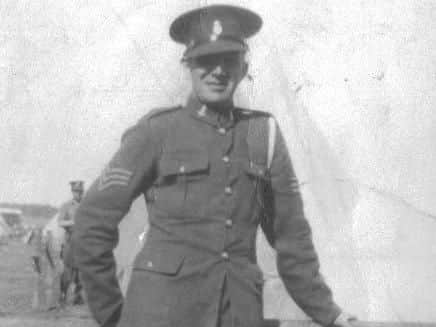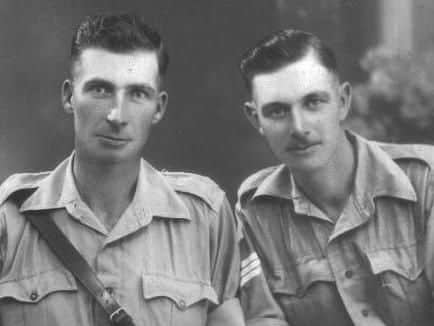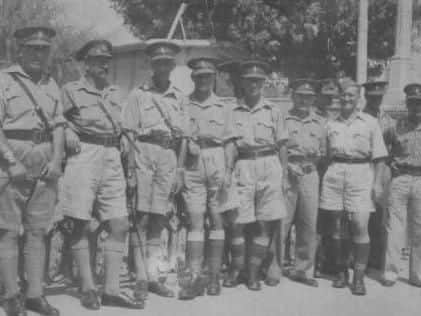The life of a Doncaster WWII soldier recalled in flashback


It was April 1933 and I'd just left the Army, after six years with The Hussars in the North West Frontier of India. You know, The Khyber Pass and all that. At first, I'd gone back to Hunslet, but Doncaster seemed a more likely place to find a job, what with all the mines and the like.
I got a job at the Plant Works and married Mary on Christmas Day, 1935. In December 1936, Carroll was born and in May 1938, our Pat. We lived in Intake at that time and all seemed pretty good,


Advertisement
Hide AdAdvertisement
Hide AdI joined The Territorials at Danum Road Barracks, where I was a musketry instructor and I really enjoyed it. On September 3, 1939, war was declared and they made me a lance sergeant in the Queen's Own Yorkshire Dragoons.
All the lads were recruited locally and not many of them knew much about horses so, when we moved to billets in Louth, we had some right fun, charging around the country and fishing the riders out of ditches and bushes. We got some cavalry reservists and officers from the Inns of Court Regiment, and Lieutenant-Colonel Warde-Aldam, from Hooton-Pagnell, took command of the Regiment. On January 1, 1940, we left Doncaster Railway Station for Dieppe and then Marseilles, where we got a ship for Haifa. It was a terrible voyage and several horses died of seasickness, poor buggers.
When the surviving horses had recovered, we had to move into Syria and, in July, we met up with some Vichy-French Druze Cavalry and gave them a proper hiding. We were just about to attack the Jebel Druze capital at Soueida, when they surrendered and we walked in and garrisoned the place.
When we returned to Palestine we were told that the horses were being taken away and we were going to be an armoured unit. We were the last horsed cavalry regiment in the British Army and it tore my heart out to lose Flash, I can tell you. He was an Australian Waler and a wonderful horse and companion.


Advertisement
Hide AdAdvertisement
Hide AdWe became part of the top secret “A-force” that built wooden tanks and trains, and camouflaged real vehicles, because it was important that the “Jerries” didn't know how weak we were.
I remember that, one day, we were watching a wooden locomotive on the Alamein line. We'd packed it with oily cloths that made black smoke when we set them on fire and, all in all, we were pretty pleased with the results. Then we heard the faint sound of an aircraft and we all dived for cover when it dived down at us. It made a pass over our heads, then turned to come back at us again. We heard the scream of a falling bomb and buried our heads into the sand, but all we heard was a dull thud, as the bomb hit the ground. At first, we thought it was a dud but, when we took a closer look, we realised it was made of wood. So much for our top secret deception plan.
We had a good laugh at that, but the next morning we were brought down to earth when some of the lads were driving our canvas tanks back from the front line, where they went each night, as a relief for the real armour. They were a few minutes late and the sun had come up over the horizon, when some German fighter bombers shot them up with armour-piercing shells. It wasn't a pretty sight.
Then, we were made part of “Delta Force,” which was to be Egypt's last line of defence. We were issued with lorries, bren-gun carriers and six pounder guns, and given seven weeks to train up.


Advertisement
Hide AdAdvertisement
Hide AdOn October 23, 1942, we drove through white tapes laid along the desert, as we had done in training, many times. This time, the horizon lit up and I was deafened by the sound of thousands of artillery guns. Shells shot over our heads and all we could do was keep going forward, towards where we thought the enemy was. This went on for days, as we tried to fill in gaps in the tanks that were trapped in minefields, as a sort of back-up in the Second Armoured Brigade. It was a very bloody battle, was Alamein.
When we broke out, on November 2, it was a real chase, I suppose. I captured a Jerry dug-out, all by myself, because they had just run out of ammunition. I took possession of a 30 foot, silk Swastika flag that they told me they were going to hang over the highest building in Alexandria. “Not now, you're not,” I said. When he came out of the forces Harry Holgate moved to Hyde Park and went back to the plant, where he worked for the next 27 years, as a shunter in the Wagon Shops. He died at Tickhill Road Hospital, on December 18 1994. The funeral service at Rose Hill Crematorium was packed.